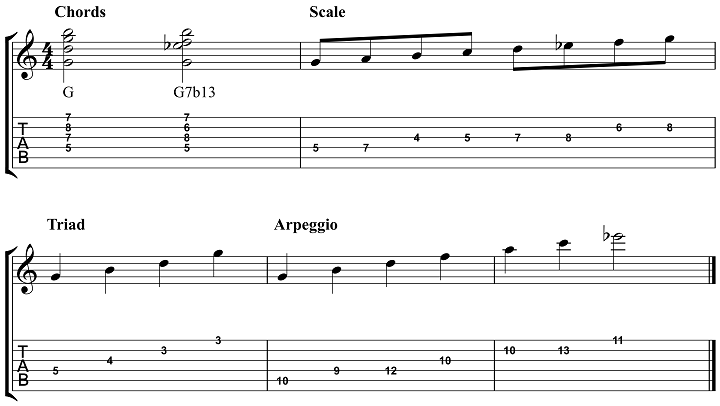The Mixolydian b6 Mode
In this series of articles we will be taking a look at the different sounds that you can build from any mode in the Melodic Minor scale, in particular the chords, scale, triad and arpeggio that go with each mode in the Melodic Minor scale system.
In today’s lesson, let’s take a look at the chords, scale, triad and arpeggio that are built from the 5th mode of Melodic Minor, the Mixolydian b6 Mode.
Besides learning a fingering or two for this important scale, it is good to know the other melodic and harmonic devices that are built from the Mixolydian b6 Mode so that you can apply these to your practice routine, as well as build your theory chops so that you recognize when to use the Mixolydian b6 Mode in your soloing and song writing.
Here is a quick look at each device from the Mixolydian b6 Mode, with further details provided below to read further.

Mixolydian b6 Triad and Chords
To begin, there are two main chords that are built from any Mixolydian b6 Mode, the Major Triad and the 7b13 chord.
The Major Triad is built from the Root, 3rd and 5th note of the Mixolydian b6 Mode, and the 7b13 chord is built by using the Root, 3rd, 5th, b7th, 9th, 11th and b13th of the same mode.
Each of these items can be played as a whole, to produce the triad/chord, or they can be plucked one note at a time to produce arpeggiated versions, both of which you saw in the tab/notation example above.
Since we only have 4 fingers to grab notes with on the fretboard, the chord for this mode is often “shrunk” down to four or five notes, as in the example above. In this case, the Root-3rd-b13th-b7th were used to build the chord, allowing you to hear the quality of the chord, Dominant 7th, and the color of the extension, the b13th, without having to rely on a 6-note chord.
So, in the key of G, the major triad would be:
G B D or R 3 5 of the Mixolydian b6 Scale
And the 7b13 chord in G would be:
G B D F A C Eb or R 3 5 b7 9 11 b13
This knowledge will help you learn to transpose these notes around the neck and into different keys as you learn to build different triads and four-note Mixolydian b13 Mode-based chords in all 12 keys.
Theory Exercise
Write out the note for each Major Triad and 7b13 chord (4 or 7 note versions) in all 12 keys.
Post your answers below and I will correct them and give you feedback if you are having any trouble writing out the notes of these triads and chords.
Mixolydian b13 Scale
The Mixolydian b13 Mode is built from the following interval structure:
Whole-Whole-Half-Whole-Half-Whole-Whole
In this pattern, whole equals a whole step (2 frets on the guitar) and half equals a half-step (1 fret on the guitar).
So, if you apply that formula to the key of G, as in the example above, you get the following notes.
G (W) A (W) B (H) C (H) D (H) Eb (W) F (W) G
Or, you will also see this scale written in numbers as such:
1 2 3 4 5 b6 b7 1
The Mixolydian Mode, and the Mixolydian b6 Mode, are both modes of the Major and Melodic Minor scale systems, and they are also very closely related.
This means that you can think of the Mixolydian b6 Mode, in theory or on the guitar, as a Mixolydian Mode with a b6.
So, you can take any Mixolydian Mode fingering that you know, lower the 6th note by 1 fret (half-step) and you have yourself a Mixolydian b6 Mode fingering.
Theory Exercise
Write out the notes of the Mixolydian b6 Mode, in all 12 keys.
Post your answers below and I will check them out and post feedback, as well as answer any questions you may have on this scale construction.
Learning the structures behind each mode that you are learning on the guitar can help shore up your theory knowledge, as well as make it easier for you to apply these modes to your solos and song writing as you learn to relate them to chords, triads and arpeggios.
If you have any questions or comments, post them below.
You are at GuitarMasterClass.net
Don't miss today's
free lick. Plus all our lessons are packed with
free content!

